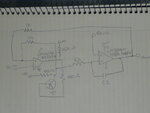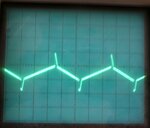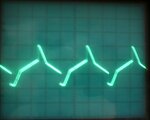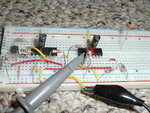someWittyName
Newbie level 4
Hello all, first post. I'm fairly new to op-amps.
I've built a triangle wave generator using this design:

Nothing too fancy here. I'm running single supply off regulated 5V. I did add a external PNP transistor to my comparator's open collector output. I wanted a bit more current than it could handle. (I'm using a comparator here because I started laying out this circuit with a relaxation oscillator feeding an integrator, but I had NO feedback into the relaxation oscillator. This did not work out too well. :wink
C1 is .1uF and R1 varies, see included photos.
The issue I'm having is on the peaks of the triangle waves, there is a large spike in the direction the output was going.
R1 = 15K

R1 = 1K

R1 = 240

And a picture of the bread board (just in case.)

So, these spikes are unexpected and unwanted. What are they caused by? What is this called and how do I go about solving it? (Have I introduced instabilities with such a large capacitance?)
I've built a triangle wave generator using this design:

Nothing too fancy here. I'm running single supply off regulated 5V. I did add a external PNP transistor to my comparator's open collector output. I wanted a bit more current than it could handle. (I'm using a comparator here because I started laying out this circuit with a relaxation oscillator feeding an integrator, but I had NO feedback into the relaxation oscillator. This did not work out too well. :wink
C1 is .1uF and R1 varies, see included photos.
The issue I'm having is on the peaks of the triangle waves, there is a large spike in the direction the output was going.
R1 = 15K

R1 = 1K

R1 = 240

And a picture of the bread board (just in case.)

So, these spikes are unexpected and unwanted. What are they caused by? What is this called and how do I go about solving it? (Have I introduced instabilities with such a large capacitance?)